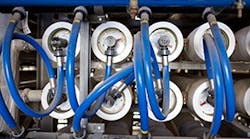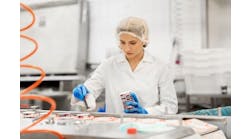Wastewater doesn’t have to be all waste.
Economical disposal of the water that food and beverage plants have left over after processing and cleaning is a major problem for most plants. Usually that means reducing the volume as much as possible; in many cases, it means cleaning the water up before discharge, to avoid crippling surcharges (or outright rejection) from the local municipal water treatment plant.
But a good way to mitigate the expense of wastewater is to put it to work, so to speak. That means using or selling substances that are extracted from the water in the normal course of cleaning it up, or even reusing the water itself, internally or otherwise.
Strategies for “mining” wastewater depend on the volume and nature of the wastewater itself, which is determined by a plant’s pretreatment methods. These will almost always be decided by considerations such as the maximum allowable parameters for volume and pollution metrics, as well as the plant’s physical constraints and capacity; does it, for instance, have the room for a big settling pond needed for aerobic treatment? Recovery options are usually a secondary consideration, but they have the potential to take a big bite out of treatment costs.
[javascriptSnippet ]
Recovery of potentially valuable solids from wastewater has progressed in recent years, in terms of both the technology involved and the industry’s willingness to use the substances in question. A common example is whey from dairy plant runoff.
Whey used to be considered a nuisance that elevated wastewater’s biochemical oxygen demand (BOD) load, a measure of how much oxygen in fresh water a wastewater stream will wipe out. At best, it was furnished to nearby farmers, if a plant was lucky enough to have any around, to spray on their fields.
But “whey protein concentrate” is now in demand, as an ingredient that boosts the protein content of a range of products (or on its own, as a powdered nutritional supplement). Some water treatment system suppliers can help make this happen.
Reverse osmosis, a technique often used in water desalinization, can also treat industrial wastewater to almost any purity standard, even potable. Photo: Suez
“Suez offers a range of technologies for the separation of milk solids or demineralization of whey, both of which are common dairy applications,” says Michael Hribljan, vice president for food & beverage at Suez Group. “For example, Suez’s electrodialysis systems can be used to further process (demineralize) whey into reduced minerals whey, which is a profitable product that is used in infant formula, ice cream, energy drinks, dry mixes and other food products.”
Other solids have a longer history of recovery from wastewater, like barley and other solids from process water used in brewing, which has long been used as cattle feed. Some of these spent grains are now getting “upcycled” into human food such as energy bars.
Methane potential
Another potential treasure in wastewater comes in the form of methane. It’s produced as a byproduct of anaerobic digester systems, which use fast-acting bacteria to break down chemical wastes in water.
Anaerobic wastewater treatment often yields methane gas that can be harnessed and used for energy. Photo: Suez
Methane is normally a nuisance gas, some 25 times worse than carbon dioxide in terms of its impact on the environment. For this reason, it’s often burned off. But capturing it and burning it off strategically, to generate electricity, can be a way to reduce energy costs.
This has been done by municipal power plants for years; private treatment plants are beginning to get in on the action. Methane generation produces power at breweries owned by Anheuser-Busch, MillerCoors and New Belgium Brewing, and at a yogurt plant owned by General Mills.
Several possibilities exist for energy produced from methane byproduct, Hribljan says: “Our anaerobic digestion technologies can help food processors convert high strength effluent or solid wastes to biomethane gas. This gas can then be used on-site in boilers for heating and steam applications in the factory or combusted to generate electricity. It can also be processed into renewable natural gas and injected into the grid.”
The water loop
But reusing the water itself is arguably the most promising recovery strategy for wastewater. It’s the most broadly applicable; it usually reduces costs, and it strikes a sympathetic chord with many consumers (and others) who find clean water a vital issue. PepsiCo and other companies have a long-term goal of being “net water-positive” – that is, replenishing into local at-risk watersheds as much or more water as its plants take in.
The easiest, most common way to use reclaimed wastewater is by “downcycling” it within the plant – using the water internally for some purpose that doesn’t require it to be potable, or as clean as it originally was. For example, it’s common to take rinsewater from the final, sanitizing phase of a clean-in-place cycle, store it and use it as the first-step prewash of the next cycle. Since its only function as prewash water is to loosen heavy soil from internal surfaces, the sanitizing chemicals still present in the rinsewater won’t matter.
Other potential downcycling uses include cooling towers, boilers, returnable glass bottle washing, agricultural irrigation, truck washing and floor washing.
Wastewater pretreatment often brings the option of recovering substances from the water, or using the water itself, to mitigate costs. Photo: Aquacycl
Downcycling is the low-hanging fruit of water strategy; it’s relatively easy to accomplish, and the returns of lower water usage are immediately apparent. But for a company that wants to drastically change its water-use profile, downcycling isn’t an adequate long-term strategy, simply because most applications can’t use that much downcycled wastewater.
“There is only so much water that you can put in the truck wash and the cooling towers and so on,” Rajendra Gursahaney, vice president-engineering for PepsiCo North America, said in a webinar produced by Aquacycl LLC. “You are left with surplus water.”
To reuse a higher proportion of wastewater, Gursahaney said, companies should devise ways to use more of it at the front of the plant. The challenge is that the closer an application comes to food contact – for instance, cleaning belts or other equipment that touches the product – the cleaner the water must be.
In theory, it would be possible for wastewater to be cleaned to potable standards, but this is rarely practical.
“Water reuse in [food & beverage] is commonly used for applications that don't come into contact with food, as there are safety, quality and other concerns,” says Orianna Bretschger, CEO and co-founder of Aquacycl. “Technically, water can be cleaned to appropriate standards that would allow reuse, but food processors are not putting recycled water back into their product (to the best of my knowledge).”
Aquacycl offers portable units for water pretreatment.
There’s another problem, as Gursahaney noted during the webinar: “There is a societal factor, what we call a ‘yuk factor.’” Consumers may balk when they’re told, perhaps by a competitor, that a beverage company is using recycled wastewater in its products; this would only be viable if it somehow became an industrywide practice, Gursahaney speculated. In any case, the viability of restoring wastewater to potable or near-potable standards mostly depends on how expensive fresh water is in the plant’s location.
Keep it local
The water situation in a given location, in fact, will be an important if not the primary determinant of an individual plant’s overall wastewater strategy. This includes considerations like the cost of fresh city water and the regulations governing the makeup of wastewater arriving at a municipal treatment plant.
Local regulations also will determine the viability of what some experts call one of the best long-term strategies for reusing wastewater: sharing it between local industries. So-called “end of pipe water,” the hardest to reuse, could theoretically be sent from a food plant to a nearby cement factory or some other application that can use water that isn’t completely clean.
The obvious primary challenge with such an arrangement is finding nearby locations that need and want wastewater. A secondary one may come from the local water authority taking the view that once wastewater leaves the pipe, it becomes public property, said Paul Bowen, a former water and sustainability executive at Coca-Cola, during the Aquacycl webinar.
“Too many times, we’ve located next to somebody, and they’re perfectly willing to take our wastewater...for another use,” Bowen said. “But the local municipality says, ‘Oh no, you can’t do that. That’s our water, and you’re just temporarily using it and you have to give it back to us, because we want to sell it to this other industry.’”
Considerations like that are why wastewater strategies must be conceived and executed at the local level, taking into account the needs and regulations for whatever watershed a given plant is located in.
“When a lot of us started, we measured this replenishment on a global basis,” Bowen said. “But we’ve understood more, and I believe all of us are starting to look at the local level, that water is a very local resource. We can’t replenish [water] in Europe and have it count toward what happens in Africa.”


